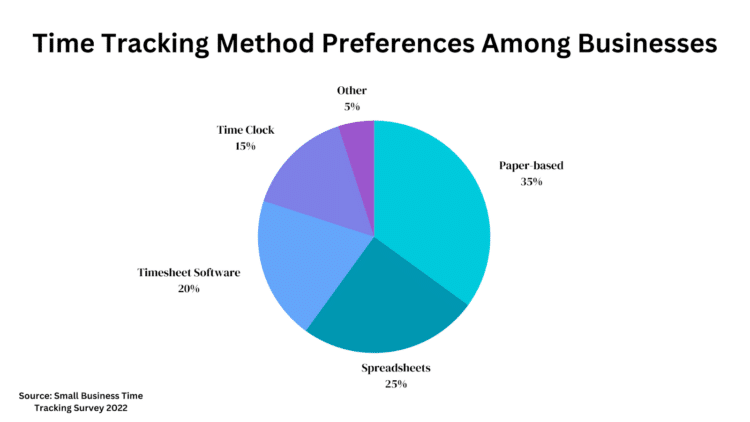Accurately tracking employee work hours is a pivotal yet often tedious task for businesses. Manually collecting and calculating time cards leaves room for human error, wasted time, and administrative headaches. This is where timesheet calculators come in to revolutionize the process.
According to a study, manual time-tracking errors can cost businesses up to 7% of their total payroll expenses. Automating time tracking with an advanced calculator provides game-changing advantages.
From streamlining payroll to boosting productivity, the benefits span across operations. For modern enterprises, implementing a timesheet calculator is no longer a luxury, it’s a necessity. Let’s explore the manifold ways these tools are transforming time management:
The Game-Changing Role of Time Card Calculators
Tracking work hours can be an exercise in frustration. Employees fill out time cards. Managers collect and verify them. Payroll staff calculates work durations and absences. One small mistake can throw the whole system out of whack.
Automating the process of tracking work hours has revolutionized businesses, saving valuable time and minimizing errors. This evolution has made timesheet calculators indispensable in today’s fast-paced work environment.
Timesheet calculator automation eliminates the need for manual verification, calculation, and data entry. Employees simply log their hours worked, breaks, overtime, etc. in the system. The calculator handles everything else automatically using predefined policies and rules.

The above data shows the time tracking methods preferred among most businesses. This streamlines payroll processing, improves accuracy, and reduces administrative workload. Managers gain back time to focus on strategy rather than paperwork. For growing organizations, automating time tracking is a scaling necessity.
Benefits of a Timesheet Calculator
1. Centralized Data: Simplifying Scheduling & Attendance
In the digital age, having all data in one place is not just a convenience it’s a necessity. A time card calculator eliminates manual entry, ensuring that attendance tracking is not just accurate but also efficient.
By centralizing time logs and schedules, a calculator provides a holistic overview of the workforce in real-time. Need to schedule employees for an upcoming project? All the information is right there. Want to track absenteeism trends? Just generate a report.
For managers, data-driven scheduling and attendance monitoring couldn’t be easier. The administrative headache is eliminated. Resources are optimized. And forecasting becomes effortless when historical data is a few clicks away.
2. Ensuring Accurate Payroll Processing
Payroll discrepancies can lead to distrust and dissatisfaction among employees. According to a recent study 54% of Americans have experienced pay problems with a time card calculator, businesses can ensure payroll accuracy, fostering trust and confidence in the system.
By removing manual calculation errors, the margin for payroll mistakes is near zero. Every worked hour and leave is precisely accounted for and automatically processed per company policies.
Both employers and staff can rest easy knowing compensation is always correct. Payroll automation is a win-win as it saves administrative resources while also improving employee satisfaction. The latter is critical for retention, especially in competitive labor markets.
3. Boosting Employee Satisfaction With Reliable Tools
Employees form the foundation of any organization, and their productivity soars when they feel valued. Timecard calculators ensure timely payments and keep employees informed about their contributions and recognition, promoting a motivated and engaged workforce.
A survey by Harvard Business Review found that enterprises that invested in manager-employee relationships had a 70% increase in workforce productivity. Tools like timesheet calculators foster trust and satisfaction among teams by providing reliability.
The benefits cascade across the org. Leadership can focus on goal alignment rather than micromanagement. HR resolves fewer disputes. And staff productivity sees an uplift when technology takes care of the busy work.
4. Streamlining Workforce Management With Time Card Calculators
Having understood the direct benefits to employees, it’s equally crucial to see the bigger picture. Let’s explore how time card calculators streamline overall workforce management.
Timesheet calculators unlock a trove of actionable analytics for managers. Reports provide real-time insight into team capacity, project hours, labor costs, and overtime trends. Instead of guesstimating resources, data-driven decisions optimize planning.

The tool also surfaces productivity patterns that can inform strategy. For instance, the data may reveal that Monday mornings have more clocked hours than Friday afternoons. This insight can drive more effective scheduling and staffing.
For multinational companies, calculators enable easy consolidation of data across global teams with centralized reporting. Time-tracking analytics is elevated from a chore to a competitive advantage.
5. Enhanced Forecasting and Capacity Planning
With historical data at their fingertips, managers can accurately forecast workload capacity needs and budgeting. Planning out sales initiatives, new product launches, and growth objectives becomes driven by data-based insights into the resources required.
6. Real-time Project Insights
Timesheet calculators provide up-to-the-minute project reporting on hours logged by task and employee. Managers get an instant snapshot of project health to identify bottlenecks, resource gaps, or scope creep early.
7. Central Auditing
All employee timesheets, adjustments, and exports are tracked centrally for auditing. This improves compliance, provides visibility into changes, and enhances payroll transparency.
8. Seamless Integrations
Leading solutions integrate with existing HR, payroll, billing, and ERP systems centralizing data and reducing duplicate efforts. APIs also allow custom integrations with legacy tools.
9. Accessibility Across Devices
With mobile support, employees can clock in or out and access schedules and timecards on the go via smart devices. This enables easy tracking even for remote or field employees.
10. Automated Overtime Rules
Preconfigured overtime policies are automatically applied in real-time based on hours worked in a day/week. This prevents overtime slipups and ensures proper compensation when additional hours are logged.
Choosing the Right Time Card Calculator
With the benefits abundantly clear, choosing the right time-tracking calculator is critical for effective implementation. Here are key factors to evaluate:
1. User Experience
The system must have an intuitive interface for rapid employee adoption across roles and devices. Convoluted systems lead to engagement issues.
2. Integration & Customization
Seamless integration with payroll, HRIS, billing, and other software is crucial for leveraging data and workflows. API support and customization options are ideal.
3. Reporting & Analytics
Robust reporting and analytics enable actionable business insights. Evaluate how easy it is to generate and customize reports.
4. Data Security
Strict access controls, encryption, and data protection policies are a must. Audit logs should track all system access and changes.
5. Support & Training
Ongoing support and training resources ensure employee proficiency and help desk assistance if needed.
6. Budget
Cost varies based on business size and features. However, the value generated typically outweighs SaaS fees.

Doing due diligence is well worth the effort. With the right timesheet calculator, it’s effortless to unlock huge time and cost savings through workforce management optimization.
Key Points
By implementing automated time card calculators, enterprises can realize manifold benefits:
- Streamlined and error-proof payroll processing
- Increased productivity and cost savings
- Data-driven scheduling, forecasting, and reporting
- Higher employee satisfaction through system reliability
- End-to-end workforce management optimization
Conclusion
In today’s dynamic business landscape, fast yet accurate time tracking is critical. As organizations scale, reliance on manual processes and paperwork is a recipe for inefficiency.
When evaluating solutions, be sure to choose a calculator aligned with specific business needs in factors like usability, security, and analytics. With smart adoption, enterprises can revolutionize time management in the digital age. The investment pays continuous dividends across operations.
Frequently Asked Questions
1. How do time card calculators differ from traditional time-tracking methods?
Time card calculators are automated systems that integrate rules to calculate hours worked, overtime, schedules, and time off. This eliminates manual verification, calculations, and data entry needed in paper-based tracking.
2. What challenges may businesses face when implementing a time card calculator?
Change management and employee adoption issues can occur if the tool is too complex. Lack of integration with other systems can also limit holistic data utilization. Proper training and support are key for smooth onboarding.
3. How can businesses balance time-tracking analytics with employee privacy?
Transparent data usage policies, access controls, and consent processes help preserve privacy. Reports should aggregate data instead of revealing information on individual employees.












Leave a Reply